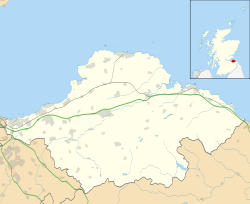Structure
The small tower is at the end of a lane in the town of Tranent, which has grown up around it. The remains are protected as a Scheduled Ancient Monument. [3]
There are two vaulted chambers in the basement. There is a main block of three storeys, and a four-storey stair-wing. It has a pantiled roof. The first floor included the hall. The tower is in a poor state of repair. [1] The stair-wing is at the south-west corner. The entrance is to the south, as are most of the windows. This suggests that there was a barmkin on this side, but there is no other evidence for this. [3]
The tower, which measures 11.2 by 7.6 metres (37 by 25 ft), [4] is constructed in buff and brown sandstone rubble. It is likely that there was a corbelled out watch-chamber at the head of the stair which was later made into a dovecote which had a single-pitch roof. There were crow-stepped gables. The roof was still pantiled in the mid-20th century, but this is unlikely to have been its original covering and the upper storey may have been considerably reworked.
There is a cross wall subdividing each floor. These walls appear to be early insertions. Probably there were earlier, less permanent, cross partitions. The hall has a large blocked fireplace, a lavabo, aumbries, and what may be a buffet recess in the north wall. [3]
This page is based on this
Wikipedia article Text is available under the
CC BY-SA 4.0 license; additional terms may apply.
Images, videos and audio are available under their respective licenses.

